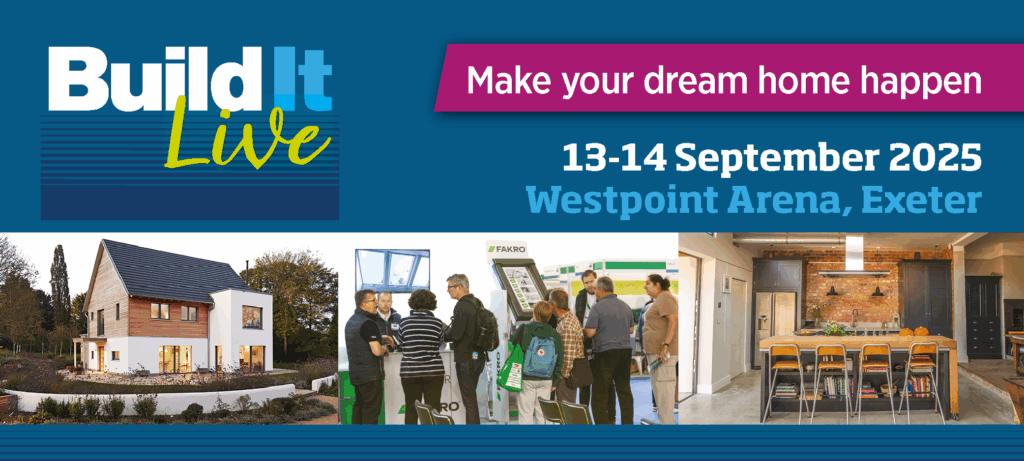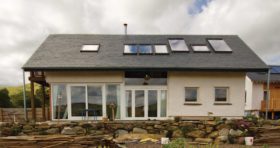
Let us help at Build It Live
Claim your two free tickets here!
Let us help at Build It Live
Claim your two free tickets here!On Joshua Penk’s 20th birthday in 2009, he poured the steps for his new home. “Building had always been on the cards for me. The plot has been in the family for quite some time,” he says.
In fact, Joshua is in the third generation of his family to self-build. The large, stunning plot where his home now stands is set deep in Cornish woodlands near the south coast and was bought from his grandmother in 1989.
Joshua first became inspired by sustainable building when he did work experience on an award-winning local school with his father’s design practice, ARCO2. He later delayed going to university so he could work; first in the practice’s offices, and later on his self-build.
“It was important to learn the system of building. The practice does all the elements of a job, from planning to production,” says Joshua, who drew up his own home’s design at the same time. The result is a striking, single storey, two bedroom property built in a curve, using a post and beam system with cedar cladding and a spectacular glazed south elevation.
“I knew that a single storey would be easier to keep low impact, and it was also much simpler to stick to a small budget,” says Joshua. “But primarily, it was a stylistic decision inspired by the design of Japanese homes.”
The hands-on self-builder did almost all the work himself on a shoestring budget of under £82,000, so was keen to avoid using heavy machinery and permanent scaffolding. “We managed to do the building with no scaffolding at any stage of the project, using a block and tackle,” he says.
The lightweight structure sits on pad foundations, with a cantilevered room over a stream to the north. The design embraces many of the latest sustainable building techniques. “It’s very eco-friendly,” says Joshua. “There are no synthetic materials, so it’s extremely breathable.”
Joshua’s family gained permission on the plot in the 1980’s and had laid services at the time, which helped with the budget. Nevertheless, the original permission had lapsed, and he had to re-apply for full consent – which was granted.
In keeping with the ethos of the whole project, he undertook his own tree, soil contamination and mining surveys (with a little help from a geologist neighbour). In fact, Joshua avoided using consultants and sub-contractors throughout – with the exception of a plumber and an electrician to do the final fix, commission and sign off.
As a result, he quickly learned various new building skills. “I learned to start in an inconspicuous area first and gradually improved, as there is so much repetition,” he says. “On each birthday, I recruited the entire family to do different jobs. There were three generations of us; it was a lovely experience.”
The key to the success of this build has been Joshua’s choice of materials, which are natural and locally sourced. For example, the wool insulation is a by-product of the fleece industry in the south west, and was collected for Joshua by an agricultural merchant. The straw insulating material is from his uncle’s farm.
The Douglas fir posts came from Duchy Timber in Cornwall and the cladding from a tree on the plot, which was felled during the preliminaries. “We think it is white cedar or macrocarpa. We milled it on site into large planks in 2008 and left it to season,” says Joshua.
The house is raised off the ground, with big roof overhangs so the straw and wool insulation doesn’t get wet. The radial frame is built from gulam beams (sourced from Finland, as there were no production manufacturers in the UK at the time) and is knitted together with home-engineered joists in the floor, roof and walls.
The lightweight building rests on 50 pad foundations, each filled with low grade concrete. The posts sit on top of these, inside concave saddle stones. “We were proud of those, as they cost about £2 each, while the proprietary feet were more than 10 times that cost,” says Joshua.
Rather than buy a ready-made green roof system, Joshua designed his own ‘breathing roof’, using water-resistant bitumen board, a rubber-based liner, battens and a structural ‘bubble wrap’. The top is spot planted with little sedum and ferns, which were free seconds rescued from a commercial project as they came off a damaged roll.
When it came to heating, Joshua chose to combine the traditional with the cutting edge. “I knew I wanted to go log-fuelled, as the woodland can amply support my needs.” he says.
He searched the internet and found Welsh company Grey Metal, who supplied him with a woodburning stove, backburner and oven for just £650. “The setup heats two cylinders of hot water, one of which supplies the underfloor heating,” says Joshua. “In the summertime much of the domestic hot water is provided by rooftop solar thermal panels from Navitron.”
The solar room on the south elevation, which runs the length of the house, is designed to buffer heat loss and gain, keeping the living space at an optimal temperature. Joshua is very proud of this element of the design.
The interior finish is as original as the construction, and Joshua describes it as “neutral, modern design.” Most immediately noticeable are the walls, which are finished either with birch plywood or with a product called Panelmox, which is pressure treated gypsum and wood fibre that doesn’t need finishing.
He sanded and painted the floor with a water-based acrylic varnish to look like poured concrete. “As a self-builder, this was much simpler to do. It looks like concrete and also transfers heat well and is easy to repair,” he says.
While he remains an architecture student, Joshua’s house is let to his aunt, but he returns in the holidays to enjoy the result of all his hard work, energy and vision. “It’s nice when I get to come home and spend time here,” he says.

Hello,
I am very much inspired by your house. I would love to see a floor plan of your design to give me some scale. Seriously thinking of trying to emulate a build similar to yours. Many thanks.
Tim
[email protected]
Hi, I too am very inspired and am currently looking for a plot of land to build on, I also have a tight budget. Just wondering if it is possible to see your plan and share your knowledge.
Yes, without a floorplan and sizes how do we know what you get for the money? Surely the point of the article?
Hi there,
I must let you know that this is a fabulous house. There was an option to ‘view detailed layout and plans’ but nothing happened when clicked. Are there details, plans, or drawings available for this house?
Thanks.